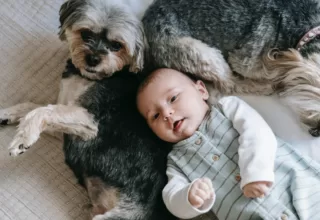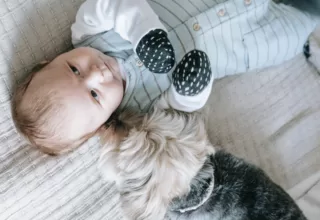How do I stop my dog from jumping on my baby?
Article Outline
- Introduction
- Understanding the Behavior
- Why do dogs jump on babies?
- The risks involved
- Establishing Boundaries
- Consistent training and commands
- Positive reinforcement techniques
- Supervision and Management
- Creating safe spaces for the baby
- Using baby gates and playpens
- Socializing and Desensitizing
- Exposing the dog to baby-related stimuli
- Controlled interactions with the baby
- Redirecting and Diverting
- Teaching alternative behaviors
- Offering distractions and rewards
- Seeking Professional Help
- Consulting a dog trainer or behaviorist
- Identifying underlying issues
- Patience and Persistence
- The importance of consistent training
- Celebrating progress
- Conclusion
- FAQs
Dogs are known for their boundless enthusiasm and eagerness to interact with their human family members. However, when a dog starts jumping on a baby, it can be concerning and potentially dangerous. In this article, we will explore effective strategies to help you prevent your dog from jumping on your precious little one.
Introduction
Introducing a baby into a household with a dog requires careful consideration and preparation. Dogs may not initially understand the arrival of a new family member and can express their excitement or curiosity through jumping. However, it’s crucial to address this behavior to ensure the safety and well-being of both your dog and your baby.
Understanding the Behavior
Why do dogs jump on babies?
Dogs may jump on babies for various reasons. It could be their way of seeking attention, expressing excitement, or simply trying to establish dominance. Dogs may also jump on babies out of curiosity or as a response to unfamiliar stimuli. Understanding the underlying motives behind this behavior is the first step toward addressing it effectively.
The risks involved
While some dogs may jump on babies with good intentions, it can pose risks. Dogs have sharp claws and strong paws, which can accidentally harm a baby’s delicate skin or cause them to lose balance and fall. Additionally, a boisterous dog might inadvertently knock over a baby, leading to potential injuries. It is vital to take proactive measures to prevent such incidents.
Establishing Boundaries
Consistent training and commands
Training your dog consistently is key to curbing the jumping behavior. Teach them basic commands like “sit,” “stay,” and “off” to establish boundaries. By reinforcing these commands, you can guide your dog to understand what is expected of them in the presence of the baby. Consistency is crucial in reinforcing the desired behavior.
Positive reinforcement techniques
Positive reinforcement is an effective training method that encourages desired behaviors by rewarding the dog. When your dog remains calm and avoids jumping, offer verbal praise, treats, or affection as a reward. This approach reinforces their understanding that good behavior is rewarding, making them more likely to repeat it.
Supervision and Management
Creating safe spaces for the baby
Designate certain areas of your home as safe spaces for your baby. Use baby gates to restrict your dog’s access to these areas when necessary. This allows you to separate them while still providing opportunities for controlled interactions.
Using baby gates and playpens
Baby gates and playpens serve as physical barriers between your dog and baby, ensuring their safety. These barriers enable your baby to play and explore freely while preventing your dog from jumping on them or getting too close. It’s essential to choose sturdy and secure baby gates or playpens to ensure the dog cannot knock them over or escape.
Socializing and Desensitizing
Exposing the dog to baby-related stimuli
Gradually introduce your dog to baby-related stimuli, such as baby sounds, toys, and accessories. This exposure helps them become familiar with these new elements and reduces their excitement or curiosity when the baby is around. Start with low-intensity exposure and gradually increase the level of interaction.
Controlled interactions with the baby
Supervised interactions between your dog and baby are crucial for their relationship development. Always ensure that both the dog and baby are calm and relaxed during these interactions. Allow your dog to approach the baby under controlled conditions, using a leash or barrier if necessary. Reward and praise your dog for calm and gentle behavior around the baby.
Redirecting and Diverting
Teaching alternative behaviors
Redirect your dog’s attention and energy toward more appropriate behaviors when they show signs of jumping. Teach them alternative commands, such as “sit” or “down,” and encourage them to perform these actions instead. By redirecting their focus, you can effectively replace the jumping behavior with a more desirable one.
Offering distractions and rewards
Provide your dog with engaging toys, puzzles, or chew treats to keep them occupied and mentally stimulated. This helps divert their attention away from jumping on the baby. Additionally, reward your dog when they choose not to jump, reinforcing their understanding of appropriate behavior.
Seeking Professional Help
Consulting a dog trainer or behaviorist
If your dog’s jumping behavior persists despite your efforts, consider seeking professional help from a qualified dog trainer or behaviorist. They can assess the situation, provide expert advice, and offer customized training techniques to address the specific needs of your dog. Professional guidance can be invaluable in overcoming challenging behaviors.
Identifying underlying issues
Sometimes, jumping behavior may stem from underlying issues, such as anxiety or fear. A professional can help identify and address these issues, providing appropriate solutions and strategies to alleviate your dog’s anxiety. By addressing the root cause, you can effectively prevent jumping on the baby.
Patience and Persistence
The importance of consistent training
Consistency is key when it comes to training your dog to stop jumping on the baby. Set clear boundaries and consistently reinforce the desired behavior. Remember that it takes time for your dog to unlearn the habit of jumping, so patience and persistence are crucial throughout the training process.
Celebrating progress
Acknowledge and celebrate small victories along the way. When your dog demonstrates improved behavior around the baby, commend their efforts and reward them. Positive reinforcement strengthens the bond between you and your dog while encouraging them to continue practicing appropriate behavior.
Conclusion
In conclusion, addressing and preventing your dog from jumping on your baby requires a combination of consistent training, supervision, redirection, and patience. By understanding the underlying reasons for this behavior and implementing the strategies outlined in this article, you can create a safe and harmonious environment for both your dog and your baby.
Remember, every dog is unique, and the effectiveness of these methods may vary. If you encounter challenges or feel overwhelmed, don’t hesitate to seek professional assistance. With dedication and the right approach, you can foster a loving and respectful relationship between your dog and your baby.
FAQs
Q1: Will my dog ever completely stop jumping on my baby?
While it is possible to significantly reduce and manage jumping behavior, complete elimination can vary depending on factors such as your dog’s breed, temperament, and training consistency. With proper training and management, you can create a safer environment for your baby.
Q2: Is it safe to leave my dog alone with my baby once the jumping behavior is under control?
It is essential to exercise caution when leaving your dog alone with your baby, even if the jumping behavior is under control. Always prioritize safety by supervising their interactions and gradually increasing the duration of unsupervised time as trust is built between your dog and baby.
Q3: My dog gets overly excited when visitors come with their babies. How can I manage this behavior?
If your dog becomes excited around visitors with babies, it’s crucial to implement the same training techniques and boundaries as you would at home. Practice controlled introductions, reinforce calm behavior, and provide distractions to redirect their focus. Consistency is key in managing excitement around babies.
Q4: Should I punish my dog for jumping on the baby?
Punishment is not recommended when addressing jumping behavior. Instead, focus on positive reinforcement and redirection. Punishment can create fear and confusion, potentially damaging the bond between your dog and baby. Positive training methods are more effective and promote a healthier relationship.
Q5: Can I train an older dog to stop jumping on my baby?
Yes, it is possible to train an older dog to stop jumping on your baby. While it may take more time and patience, consistent training and positive reinforcement can help modify their behavior. Seek professional guidance if needed to tailor the training to your dog’s specific needs.
How useful was this post?
Click on a star to rate it!
Average rating 5 / 5. Vote count: 1
No votes so far! Be the first to rate this post.



